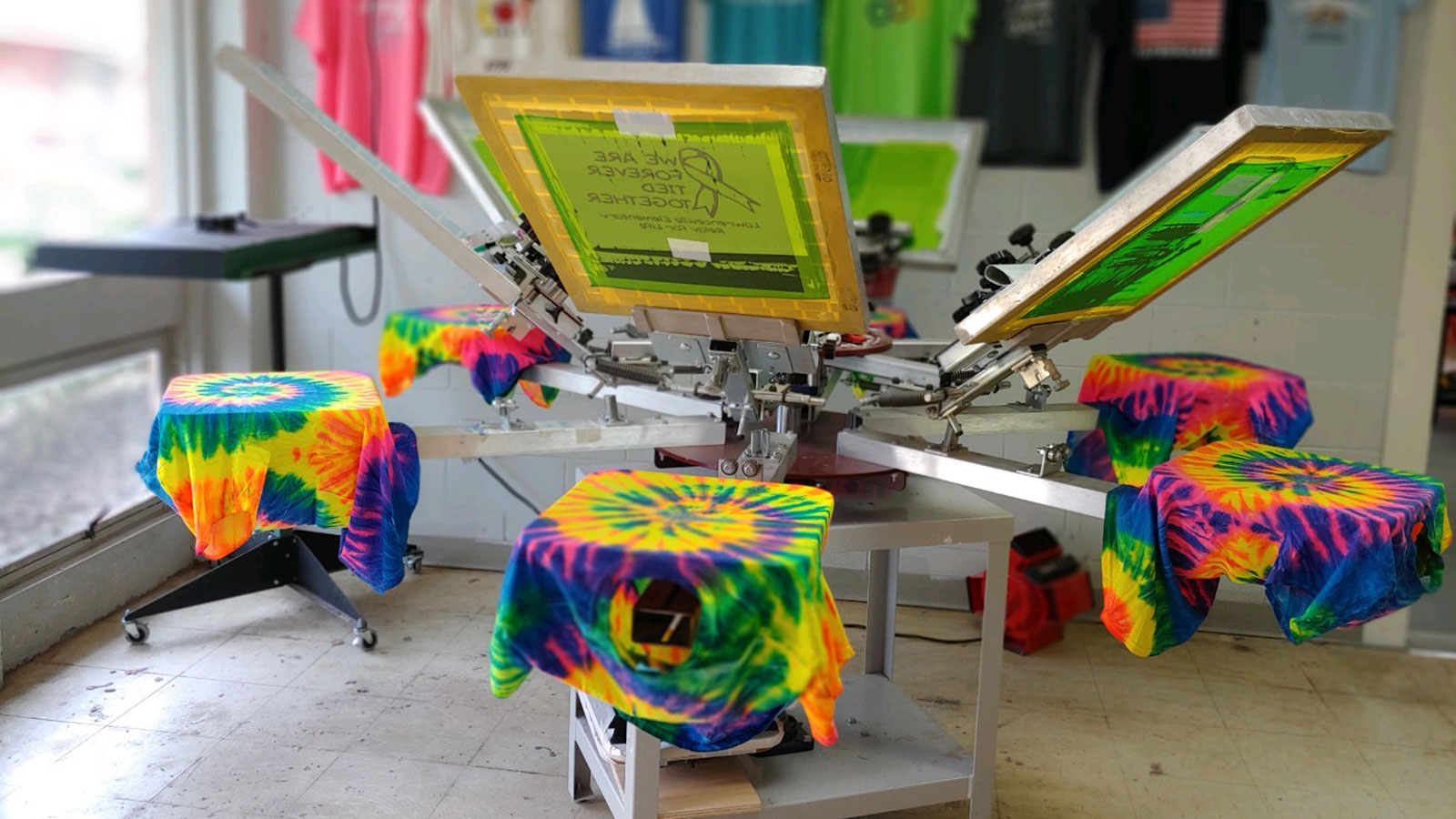Affordable Screen Printing Kit for Home Use
Wiki Article
Display Printing Uncovered: Everything You Required to Understand About Tee and Garment Printing Techniques
If you have actually ever asked yourself how those vibrant styles finish up on your preferred t-shirts, you remain in the appropriate location. Display printing is a fascinating technique that combines art with method, providing limitless possibilities for imagination. Recognizing the principles, from devices to ink selections, can significantly impact your results. Prepared to explore the crucial components that make display printing an art type? Let's uncover the details that can boost your tasks.
The Essentials of Display Printing: Exactly How It Works
When you plunge into screen printing, you'll discover it's both an art and a science. At its core, screen printing involves developing a stencil, or display, that permits ink to go through only in details areas (screen printing kit). You begin by selecting your design and preparing your display with a light-sensitive emulsion. When you expose this solution to light, it hardens, leaving your layout as an adverse area.Placement the screen over the textile, then utilize a squeegee to press ink through the screen onto the garment. Each step is crucial, and mastering them will boost your display printing skills, transforming simple garments right into special, expressive items.
Sorts Of Screen Printing Methods
Once you grasp the essentials of display printing, it's time to explore the numerous techniques that can boost your layouts. One popular technique is traditional display printing, where ink is pressed via a stenciled display. This technique is terrific for vibrant, vivid shades. There's water-based ink printing, which uses a softer feel and is environment-friendly, however it requires a different approach to curing.If you're going for fine details, take into consideration discharge printing. This technique removes color from the textile, leaving a soft, vintage look. One more option is plastisol printing, understood for its sturdiness and vibrant colors, making it a preferred for numerous brand names. Experiment with halftone printing to develop gradient results and elaborate designs. Each method has its distinct beauty, so do not be reluctant to try them bent on discover what suits your design best!
Important Equipment for Display Printing
To achieve magnificent results in display printing, having the ideal tools is fundamental. You'll require a tough screen printing frame, which holds the mesh that transfers your design onto the garment. Next, spend in premium mops; these are vital for applying ink uniformly across the screen.Selecting the Right Inks and Products
When selecting inks and materials for display printing, you require to take into consideration the kind of ink that functions best for your project. Think regarding textile compatibility to guarantee your designs look great and last lengthy. Additionally, discover green ink options to make your printing process more sustainable.Types of Display Inks
Selecting the appropriate screen ink is crucial for achieving lively, sturdy prints that meet your project's requirements. There are numerous kinds of screen inks to take a look at. Specialized inks, such as metallic or glow-in-the-dark, can include special effects to your layouts.
Textile Compatibility Factors To Consider
Recognizing material compatibility is important for achieving premium screen prints, specifically considering that different materials respond distinctively to different inks. Constantly check your inks on example fabric to assure they adhere properly and keep color honesty. Furthermore, maintain in mind that material weight and texture can influence the final result, so selecting the appropriate ink and material combination is important for your project's success.Eco-Friendly Ink Options
Environment-friendly inks are coming to be a popular choice for screen printers who desire to lessen their environmental effect while preserving top quality. When selecting inks, think about water-based inks, which are much less unsafe and simpler to cleanse up compared to standard solvents.In addition, seek inks made from renewable energies, such as soy or vegetable-based choices. By picking the right inks and materials, you'll not only create magnificent layouts yet also contribute to an extra lasting printing process. Make the button, and your prints will certainly reflect your dedication to the environment!
Preparing Your Design for Screen Printing

File Format Requirements
To assure your style looks sharp and vivid on textile, you'll require to pay close interest to submit layout requirements for display printing. Make sure your design has a clear history to prevent undesirable white edges on your prints. Keep shade modes in mind; CMYK is conventional for screen printing, so convert your RGB develops appropriately.Shade Splitting Up Strategies
Color splitting up is a necessary action in preparing your style for screen printing, and understanding it can significantly enhance your print quality. You'll need to break your design into private colors, as each color needs a separate screen throughout printing. Beginning by recognizing all the colors in your design and create layers each. You can make use of software program like Adobe Photoshop or Illustrator to separate and separate colors properly. Be particular to save each layer as a different file, typically in a style like TIFF or PSD. This accuracy not just assures accurate shade depiction yet also streamlines the printing procedure. By taking note of color splitting up, you'll accomplish dynamic and professional lead to your screen-printed garments.Resolution and Dimension
Accomplishing the most effective results in screen printing begins with guaranteeing your layout has the right resolution and size. Ideally, your artwork needs to be at least 300 DPI (dots per inch) for sharp, clear prints. If you utilize lower resolution, your end product may look pixelated and amateur.When it comes to dimension, think about the dimensions of your print area. Style silk screen printing your artwork to match the final print size, preferably developing it in the actual dimensions you'll be printing. In this manner, you'll prevent any kind of unexpected scaling concerns.
Always examine your design in both vector and raster styles. Vector graphics can be scaled without shedding high quality, making them excellent for screen printing. Preparing properly will assure your layout looks amazing on every garment!
Step-by-Step Display Printing Refine
Display printing is a dynamic process that enables you to create dynamic designs on various surface areas. To obtain begun, you'll require a display, solution, and your picked ink.Put ink onto the display and make use of a squeegee to push the ink via the stencil onto the material. Lift the display very carefully and allow the print dry. You have actually effectively screen published your layout.
Tips for Effective Display Printing Projects
While you're diving into your screen printing projects, bear in mind that preparation is vital to success. Start by gathering all your products-- inks, squeegees, displays, and garments. A tidy work space aids protect against undesirable mistakes, so clean up prior to you start.Following, validate your artwork is high-resolution and properly sized for your garment. Test your display for correct exposure and tidy it completely to stay clear of smudges. When mixing your inks, follow the producer's standards to achieve the ideal consistency.
During printing, use also pressure with your squeegee for constant outcomes. Don't rush; take your time to validate each print meets your requirements. After printing, allow your garments dry totally prior to managing or packaging them.
Lastly, always maintain a sample of your help future referral. By doing this, you can analyze your progress and improve your techniques with time. Satisfied printing!

Regularly Asked Concerns
How much time Does It Require To Establish a Display Printing Task?
Establishing a screen printing work normally takes about half an hour to an hour. You'll prepare the screens, mix inks, and readjust journalism. The moment varies based on intricacy and experience, so remain arranged!Can I Publish on Different Fabric Keys In Making Use Of the Very Same Strategy?
Yes, you can publish on various fabric types utilizing the exact same strategy, however you'll require to adjust your settings and inks. Some fabrics absorb ink in different ways, so trying out assurances the most effective results for each and every material.What Are Usual Errors to Stay Clear Of in Display Printing?
When display printing, stay clear of usual mistakes like using the wrong ink, disregarding proper exposure times, or avoiding pre-press checks. Always check your configuration and maintain tidy screens to guarantee high quality outcomes each time.How Can I Correctly Clean and Preserve My Display Printing Devices?
To appropriately tidy and maintain your screen printing tools, you ought to routinely wash screens with ideal solvents, inspect squeegees for wear, and ensure all tools are kept dry and dust-free. Consistency stops pricey repairs and boosts performance.Is Screen Printing Ecologically Friendly Compared to Various Other Methods?
Screen printing can be more eco pleasant than other approaches, particularly if you utilize water-based inks and eco-conscious products. By selecting lasting products and techniques, you minimize waste and lessen your influence on the planet.Screen Printing Uncovered: Everything You Required to Know About Tee and Garment Printing Strategies
At its core, display printing entails creating a pattern, or screen, that enables ink to pass via just in details areas. Setting the display over the material, then make use of a squeegee to press ink via the screen onto the garment. One prominent technique is typical display printing, where ink is pressed with a stenciled screen.When choosing inks and products for screen printing, you require to take right into account the type of ink that functions ideal for your project.
Report this wiki page